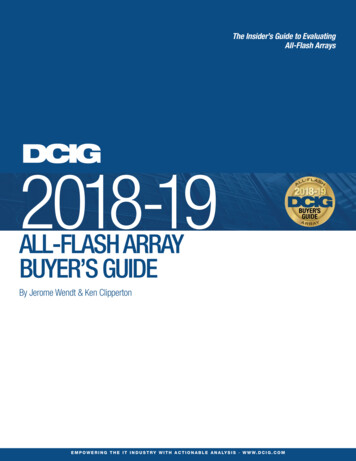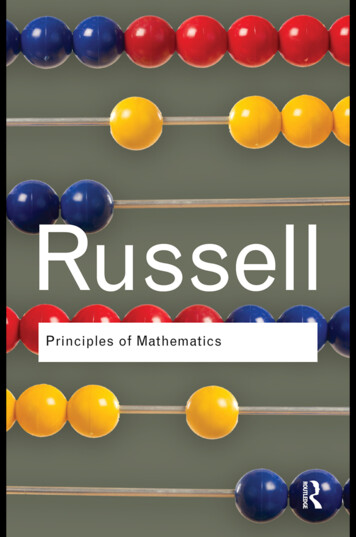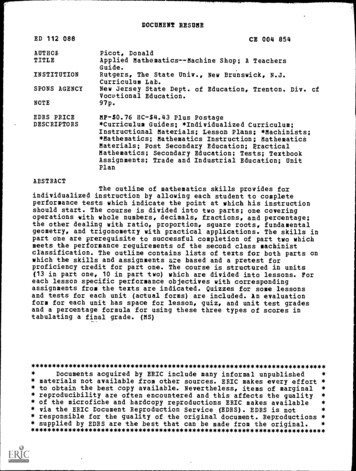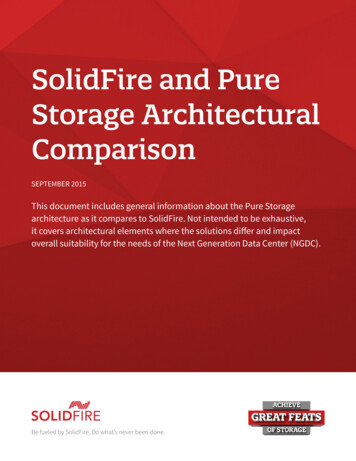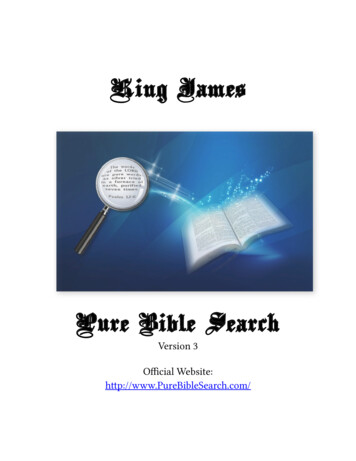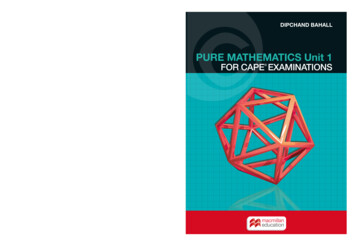
Transcription
DIPCHAND BAHALLPURE MATHEMATICS Unit 1PURE MATHEMATICS Unit 1FOR CAPE EXAMINATIONSFOR CAPE EXAMINATIONS for students pursuing courses at tertiary institutions throughout theCaribbean. Each topic is covered in depth with additional material inareas that students find most challenging.Also available:Mathematics Solutionsfor Advanced Proficiency1998-2008About the authorDipchand Bahall has over 20 years’ experience teaching Advanced LevelCAPE Mathematics Solutions contains fully-worked solutions to all of the papers set for the CAPEMathematics examinations from its inception in 1998: Unit 1: Papers 1 and 2 1998-2008 Unit 2: Papers 1 and 2 1999-2008The book includes: a list of formulae/theorems/laws consistent with the updated CAPE Mathematics syllabus revision tips to assist students preparing for their examinations examination tips to help students develop a strategy for tackling the examinationsMathematics at Presentation College and St Joseph’s Convent in Trinidad andThis book is designed to facilitate teachers, students and anyone interested in pursuing a coursein Pure Mathematics. Past paper questions can be attempted and answers checked against thosein this book. Each solution is fully worked so that students can see how each answer has beenobtained. It is an ideal resource for consolidation, practice, revision and developing problemsolving skills.Melissa B. Gajadhar received the Diploma in Education and the B.A. degree in Mathematics at theUniversity of the West Indies, St. Augustine, Trinidad. She is presently teaching at PleasantvilleSenior Comprehensive School, San Fernando. She has participated in the CAPE Marking Exercisefor the past six years, the last two years as an Examiner in Pure Mathematics and on the previousoccasions as an Assistant Examiner in Pure Mathematics.Tobago, and at Cayman Prep and High School. He holds a Masters DegreeRashad R. Modikhan received the Diploma in Education and the B.Sc. degree in Mathematics atthe University of the West Indies, St. Augustine, Trinidad. He has taught at Saint Mary’s College,Trinidad, WI and is presently at Presentation College, Chaguanas, Trinidad. He has participatedin the CAPE Marking Exercise as an Assistant Examiner in Pure Mathematics for the past threeyears.in Statistics, a Diploma in Education (Teaching of Mathematics) and a BSc inwww.macmillan-caribbean.comI S B N 978-0-230-71804-3Mathematics. Dipchand is presently a Senior Instructor at The University of Trinidad9780230 718043CAPE MATHS SOLUTIONS COVER REPRO.indd 115/7/09 15:00:30and Tobago, Point Lisas Campus.DIPCHAND BAHALLKey features: Objectives at the beginning of each chapter aid planning, focus learning andconfirm syllabus coverage Key terms are highlighted to develop students’ vocabulary throughout the course A wide variety of exercises develops students’ knowledge, application and abilityin all areas of the syllabus Worked solutions throughout the text provide students with easy-to-followexamples of new concepts Graded excercises at the end of each section can be used to check students’understanding and monitor progress Checklists and at-a-glance summaries at the end of each chapter encouragestudents to review their understanding and go back over areas of weakness Examination-style questions at the end of each module give students plenty ofpractice in the types of questions they’ll meet in the examinationsPURE MATHEMATICS Unit 1of the new CAPE Pure Mathematics syllabus. They offer a sound platformFOR CAPE EXAMINATIONSThe two books in this series provide complete coverage of Units 1 and 2CAPE is a registered trade mark of the Caribbean Examinations Council (CXC). Pure MathematicsUnit 1 for CAPE Examinations is an independent publication and has not been authorized,sponsored or otherwise approved by CXC.Find us on Facebook/macmillancaribbeanFind us on 0230037847 Cover.indd 1I S B N 978-0-230-03784-79780230 03784711/12/2014 09:52
PURE MATHEMATICS Unit 1FOR CAPE EXAMINATIONSDIPCHAND BAHALLCAPE is a registered trade mark of the Caribbean Examinations Council (CXC). PureMathematics for CAPE Examinations Unit 1 is an independent publication and hasnot been authorised, sponsored, or otherwise approved by CXC.
Macmillan Education4 Crinan Street, London N1 9XWA division of Macmillan Publishers LimitedCompanies and representatives throughout the worldwww.macmillan-caribbean.comISBN 978-0-2304-6575-6 AERText Dipchand Bahall 2013Design and illustration Macmillan Publishers Limited 2013First published in 2013All rights reserved; no part of this publication may bereproduced, stored in a retrieval system, transmitted in anyform or by any means, electronic, mechanical, photocopying,recording, or otherwise, without the prior written permissionof the publishers.These materials may contain links for third party websites. We have no control over, andare not responsible for, the contents of such third party websites. Please use care whenaccessing them.Designed by Tech Type and Oxford Designers and IllustratorsTypeset and illustrated by MPS LimitedCover design by Clare WebberCover photo: Alamy/Science Photo Library0800022 FM.indd 26/26/13 2:31 PM
ContentsINTRODUCTIONxiiMATHEMATICAL MODELLINGxiiiMODULE 1 BASIC ALGEBRA AND FUNCTIONSCHAPTER 1CHAPTER 2REASONING AND LOGIC2Notation4Simple statement4Negation4Truth tables4Compound statements5Connectives6Conjunction6Disjunction (‘or’)7Conditional statements11Interpretation of p q12The contrapositive12Converse13Inverse13Equivalent propositions14Biconditional statements15Tautology and contradiction17Algebra of propositions18THE REAL NUMBER SYSTEM24Subsets of rational numbers25Real numbers26Operations26Binary 8Distributivity29Identity30Inverse31Constructing simple proofs in mathematics33Proof by exhaustion33Direct proof33Proof by contradiction35Proof by counter example36iii
CHAPTER 3PRINCIPLE OF MATHEMATICAL INDUCTIONSequences and seriesFinding the general term of a seriesSigma notationExpansion of a seriesStandard resultsSummation resultsMathematical inductionDivisibility tests and mathematical induction444545474748495357CHAPTER 4POLYNOMIALSReview of polynomialsDegree or order of polynomials626363Algebra of polynomialsEvaluating polynomialsRational expressionsComparing polynomialsRemainder theoremThe factor theoremFactorising polynomials and solving equationsFactorising xn yn63646465697477CHAPTER 5INDICES, SURDS AND LOGARITHMSIndicesLaws of indicesSurdsRules of surdsSimplifying surdsConjugate surdsRationalising the denominatorExponential functionsGraphs of exponential functionsThe number eExponential equationsLogarithmic functionsConverting exponential expressions tologarithmic expressionsChanging logarithms to exponents using thedefinition of logarithmProperties of 07Solving logarithmic equations108Equations involving exponents110Change of base formula (change to base b from base a)113Logarithms and exponents in simultaneous equations115
CHAPTER 6Application problems117Compound interest118Continuous compound interest120FUNCTIONS128Relations and functions129Describing a function130The vertical line test130One-to-one function (injective function)132Onto function (surjective function)134Bijective functions137Inverse functions139Graphs of inverse functionsOdd and even functions144Odd functions144Even functions144Periodic functions144The modulus function145Graph of the modulus functionComposite functions145146Relationship between inverse functionsIncreasing and decreasing functionsCHAPTER 7141149152Increasing functions152Decreasing functions152Transformations of graphs153Vertical translation153Horizontal translation154Horizontal stretch155Vertical stretch157Reflection in the x-axis158Reflection in the y-axis158Graphs of simple rational functions160Piecewise defined functions162CUBIC POLYNOMIALS171Review: Roots of a quadratic and the coefficient of thequadratic172Cubic equations173NotationFindingα3175 β3 γ3,using a formulaFinding a cubic equation, given the roots ofthe equation175176v
CHAPTER 8INEQUALITIES AND THE MODULUS FUNCTION185Theorems of inequalities186Quadratic inequalities186Sign table188Rational functions and inequalities191General results about the absolute value function196Square root ofx2201The triangle inequality201Applications problems for inequalities203MODULE 1 TESTS208MODULE 2 TRIGONOMETRY AND PLANE GEOMETRYCHAPTER 9TRIGONOMETRY212Inverse trigonometric functions and graphs213Inverse sine function213Inverse cosine function213Inverse tangent function214Solving simple trigonometric equationsGraphical solution of sin x k214Graphical solution of cos x k216Graphical solution of tan x k217Trigonometrical identitiesReciprocal identitiesPythagorean identitiesProving identitiesSolving trigonometric equations218218219220224Further trigonometrical identities229Expansion of sin (A B)229Expansion of cos (A B)230Expansion of tan (A B)234Double-angle formulae236Half-angle formulae238Proving identities using the addition theoremsand the double-angle formulae238The form a cos θ b sin θ241Solving equations of the form a cos θ b sin θ c244Equations involving double-angle or half-angle formulae249Products as sums and differences253Converting sums and differences to products254Solving equations using the sums and differences as productsvi214258
CHAPTER 10COORDINATE GEOMETRY266Review of coordinate geometry267The equation of a circle267Equation of a circle with centre (a, b) and radius r268General equation of the circle269Intersection of a line and a circle275Intersection of two circles276Intersection of two curves277Parametric representation of a curve278Cartesian equation of a curve given its parametric form279Parametric equations in trigonometric form280Parametric equations of a circle282Conic sections285Ellipses286Equation of an ellipse286Equation of an ellipse with centre (h, k)289Focus–directrix property of an ellipse291Parametric equations of ellipses291Equations of tangents and normals to an ellipse293ParabolasCHAPTER 11294Equation of a parabola295Parametric equations of parabolas296Equations of tangents and normals to a parabola296VECTORS IN THREE DIMENSIONS (ℝ3)303Vectors in 3D304Plotting a point in three dimensionsAlgebra of vectors304304Addition of vectors304Subtraction of vectors305Multiplication by a scalar305Equality of vectors305Magnitude of a vector306Displacement vectors306Unit vectors307Special unit vectors308Scalar product or dot product309Properties of the scalar product310Angle between two vectors310Perpendicular and parallel vectors312Perpendicular vectors312Parallel vectors313vii
Equation of a line316Finding the equation of a line given a point on a lineand the direction of the line316Finding the equation of a line given two points on the line317Vector equation of a line319Parametric equation of a line319Cartesian equation of a line320Finding the angle between two lines, given the equationsof the lines322Skew lines323Equation of a plane326Equation of a plane, given the distance from theorigin to the plane and a unit vector perpendicularto the plane327Equation of a plane, given a point on the plane and anormal to the plane328Cartesian equation of a plane330MODULE 2 TESTS338MODULE 3 CALCULUS ICHAPTER 12LIMITS AND CONTINUITY342Limits343The existence of a limit345Limit laws345Evaluating limits347Direct substitution347Factorising method349Conjugate method350Tending to infinityLimits at infinitySpecial limitsContinuityTypes of discontinuityInfinite discontinuityPoint discontinuityJump discontinuity351352354358359359359359Removable and non-removable discontinuityCHAPTER 13viii360DIFFERENTIATION 1366DifferentiationThe difference quotientExistence of a derivative367368368
CHAPTER 14Notation for derivativesInterpretations of derivativesFinding derivatives using first principlesDifferentiation of ag(x) where a is a constantDifferentiation of sums and differences of functionsFirst principle and sums and differences of functions of xRate of changeChain ruleProduct ruleQuotient ruleDifferentiation of trigonometric functionsHigher LICATIONS OF DIFFERENTIATION399Tangents and normalsEquations of tangents and normalsIncreasing and decreasing functionsStationary points/second derivativesMaximum and minimum valuesStationary pointsClassification of turning pointsFirst derivative testSecond derivative testInflexion pointsPractical maximum and minimum problemsParametric differentiationRate of changeCurve sketchingPolynomials, rational functions, trigonometricfunctionsGraph of a polynomialGraphs of functions of the form f(x) xn where n is aneven integerGraphs of functions of the form f(x) xn where n is anodd integer greater than 1Graphs of polynomialsZeros of a polynomialGraphing 0430434434435435438440Graphing functions with a table of values440Solving simultaneous equations graphically444Solving inequalities graphically447Review of trigonometrySine, cosine and tangent of 45 , 30 and 60 449449ix
xGraph of cosec x450Graph of sec x451Graph of cot x451Properties and graphs of trigonometric functions452Transformations of trigonometric functions456y a sin (bx) c and y a cos (bx) c459y a tan (bx) c460Graphs of rational functionsVertical asymptotesHorizontal asymptotesSketching graphs of rational functionsShape of a curve for large values of the independentvariable461462462463CHAPTER 15INTEGRATIONAnti-derivatives (integrations)The constant of integrationIntegrals of the form axnIntegration theoremsIntegration of polynomial functionsIntegration of a function involving a linear factorIntegration of trigonometric functionsIntegration of more trigonometric functionsIntegrating sin2 x and cos2 xIntegration of products of sines and cosinesThe definite integralIntegration by substitutionSubstituting with limitsThe equation of a CHAPTER 16APPLICATIONS OF INTEGRATIONApproximating the area under a curve, using rectanglesEstimating the area under a curve using n rectanglesof equal widthUsing integration to find the area under a curveArea between two curvesArea below the x-axisArea between the curve and the y-axisVolume of solids of revolutionRotation about the x-axisRotation about the y-axisVolume generated by the region bounded bytwo curves509510466512514516517519524524527530
CHAPTER 17DIFFERENTIAL EQUATIONSFamilies of curvesClassifying differential equationsLinear versus non-linear differential equationsPractical applications of differential equationsFirst order differential equationsSolutions of variable-separable differential equationsModelling problemsSecond order differential equations543544544544544545547549552MODULE 3 TESTS558UNIT 1—MULTIPLE CHOICE TESTS561INDEX575Answers are available online atwww.macmillan-caribbean.com/resourcesxi
IntroductionThese two volumes provide students with an understanding of pure mathematicsat the CAPE level taken from both a theoretical and an application aspect andencourage the learning of mathematics. They provide the medium throughwhich a student can find problems applied to different disciplines. The conceptsare developed step by step; they start from the basics (for those who did not doadditional mathematics) and move to the more advanced content areas, therebysatisfying the needs of the syllabus. Examination questions all seem to have answersthat are considered ‘nice’ whole numbers or small fractions that are easy to workwith; not all real-world problems have such answers and these books have avoidedthat to some extent. Expect any kind of numbers for your answers; there are nostrange or weird numbers.The objectives are outlined at the beginning of each chapter, followed by thekeywords and terms that a student should be familiar with for a better understandingof the subject. Every student should have a section of their work book for thelanguage of the subject. I have met many students who do not understand terms suchas ‘root’ and ‘factor’. A dictionary developed in class from topic to topic may assist thestudents in understanding the terms involved. Each objective is fulfilled throughoutthe chapters with examples clearly explained. Mathematical modelling is a conceptthat is developed throughout, with each chapter containing the relevant modellingquestions.The exercises at the end of each section are graded in difficulty and have adequateproblems so that a student can move on once they feel comfortable with the concepts.Additionally, review exercises give the student a feel for solving problems that arevaried in content. There are three multiple choice papers at the end of each Unit,and at the end of each module there are tests based on that module. For additionalpractice, the student can go to the relevant past papers and solve the problems given.After going through the questions in each chapter, a student should be able to do pastpaper questions from different examining boards for further practice.A checklist at the end of each chapter enables the student to note easily what isunderstood and to what extent. A student can identify areas that need work withproper use of this checklist. Furthermore, each chapter is summarised as far aspossible as a diagram. Students can use this to revise the content that was covered inthe chapter.The text provides all the material that is needed for the CAPE syllabus so thatteachers will not have to search for additional material. Both new and experiencedteachers will benefit from the text since it goes through the syllabus chapter bychapter and objective to objective. All objectives in the syllabus are dealt within detail and both students and teachers can work through the text, comfortablyknowing that the content of the syllabus will be covered.xii
Mathematical ModellingA mathematical model is a mathematical description of the behaviour of some reallife system or some aspect of a real-life system. The mathematical model may be usedto find an optimal solution to a problem, answer a number of questions, date fossilsby analysing the decay of radioactive substance or model the population change of acommunity. The mathematical model makes use of identifying variables, setting upequations or inequalities and stating any assumptions and limitations within the model.In considering the motion of a ball when thrown at an angle to the horizontal, we mayignore the weight of the ball, treat the ball as a particle (we ignore the size of the ball)and assume that there is no resistance to motion. We simplify the problem and create amathematical model to find distances travelled, maximum height reached by the ball orany aspect of the motion that interests us.Construction of a mathematical modelfor a systemStep 1Identify all variables that are responsible for changing the system.Step 2State any assumptions or hypotheses about the system.Step 3Formulate the problem in mathematical terms: equations, inequalities etc.Step 4Solve the mathematical problem.Step 5Test the accuracy of the solution against the real-world behaviour.Step 6Refine the model if necessary.Mathematical modelling is not restricted to any particular topic. The real-worldsituation being analysed can be based on topics inclusive of algebra, trigonometry,calculus and statistics or a combination of these. Throughout the text there aremodelling questions for the relevant chapters.xiii
Real-worldproblemUse the model to predict,interpret and explain thereal-world solutionSimplify the realworld problemValidatethe modelCreate amodelIdentify allvariables, stateany assumptions,formulate amathematicalmodelRefine themodel nto theproblemTest thesolutionTest accuracy ofthe solution, andcompare with thereal-world behaviourxiv
1Basic Algebra andFunctions1
M O DUL E 1CHAPTER 1Reasoning and logicAt the end of this section you should be able to: Identify simple and compound propositions Identify connectives (conjunction, disjunction, negation, conditional,biconditional) Draw truth tables and identify the truth value of compound statements State the converse of a conditional statement State the contrapositive of a conditional statement State the inverse of a conditional statement Identify the logical equivalence of statementsKEYWORDS/TERMSQSPQPTJUJPO t TUBUFNFOU t TJNQMF TUBUFNFOU t DPNQPVOE TUBUFNFOU t DPOOFDUJWFT t DPOKVODUJPO t EJTKVODUJPO t OFHBUJPO t DPOEJUJPOBM t CJDPOEJUJPOBM t DPOWFSTF t DPOUSBQPTJUJWF t JOWFSTF t MPHJDBM t FRVJWBMFODF t USVUI UBCMF t UBVUPMPHZ t DPOUSBEJDUJPO t DPOUJOHFODZ2
MODULE 1 t CHAPTER 1Mathematics has been called the ‘universal language’. All equations and calculationsare interpreted in the same manner in any country of the world. ‘Reasoning andlogic’ is an area that demands your understanding of this ‘language’. It is a branch ofmathematics that tests one’s ability to manipulate words and letters. Indeed, a certainamount of ‘common sense’ is required.Consider this statement.Today is Monday.DE FIN ITI ONA propositionis a statementthat makes adeclaration that iseither true or false,but not both.EXAMPLE 1Is this a true statement? Is it false? To make any inference, one has to ‘investigate’ the‘facts’. If this statement is read on Monday, then obviously it is true. If it is read on anyother day, it becomes false. At no time can it be true and false.The following pages are aimed to ensure a comprehensive understanding of thissometimes confusing and misleading topic. We show how the use of simple grammarcan alter the meaning, interpretation and validity of a statement. It will help you toappreciate the completeness and lack of ambiguity found in mathematical logic andreasoning.Are these propositions?(a) Port-of-Spain is the capital of Trinidad and Tobago.(b) Rain is falling.(c) 4 5 12(d) 17 15 32SOLUTIONAll of the statements are propositions. They make a declaration that can be true orfalse. (a) and (d) are both true, whereas proposition (c) is false. (b) will be true if rainis falling and false if it is not falling.EXAMPLE 2Are these propositions? Give a reason for each of your answers.(a) Where are you?(b) 2x 3 12(c) x y z 4(d) What is an even number?(e)SOLUTION 2 is a rational number.(a) ‘Where are you?’ is not a proposition since it does not declare anything.(b) 2x 3 12 is not a proposition. It contains a variable x, so we cannot tellNoteThe truth or falsityof a propositionalstatement iscalled its truthvalue.whether it is true or false.(c) x y z 4 is not a proposition. It contains a variables x, y and z, so we cannot tell whether it is true or false.(d) This is not a proposition since we cannot determine whether it is true or false.(e) This is a proposition as we can declare it true or false. Since 2 is an irrationalnumber, the proposition is false.3
M O DUL E 1NotationLetters are used to denote propositional variables. If the proposition is true, its valueis denoted by T or 1. If the proposition is false, its truth value is denoted by F or 0.For example, we can denote the statement ‘π is irrational’ by the letter p. Its truthvalue is T since this proposition is true.Simple statementA simple statement is a statement that cannot be decomposed into separate statements. ‘The grass is green’ is a simple statement. This statement cannot be separatedinto separate statements.NegationD EFIN IT IO NLet q be a proposition.The negation of q is denoted by q (or q or q ) and is the statement ‘it is not the casethat q’.The truth value of q (read as ‘not q’) is the opposite of the truth value of q.EXAMPLE 3Find the negation of the proposition ‘The rain is falling’.SOLUTIONThe negation is ‘It is not the case that the rain is falling’. We can write this as ‘The rainis not falling.’EXAMPLE 4Find the negation of the proposition ‘6 is an even number’.SOLUTIONThe negation is ‘6 is not an even number’ or ‘6 is odd’.We can let p be the proposition ‘6 is an even number’ and write p is the proposition‘6 is not an even number’.Truth tablesA convenient way to identify the truth value of propositions is to set up a tableidentifying the truth value of each statement. This table is called a truth table. A truthtable for the negation is as follows:4p pTFFT
MODULE 1 t CHAPTER 1Further we can substitute 0s and 1s to rewrite the truth table as follows.p p1001In a truth table, the first row identifies the statements we are interested in (in this casep and p). The following rows give the truth value of the statement and its negation.For example, in the second row we see that when p is true, p is false. The third rowshows the reverse scenario.EXAMPLE 5Draw a truth table for the negation of ‘the answer is wrong’.SOLUTIONLet p be the statement ‘the answer is wrong’. p is the statement ‘the answer is notwrong’ and the truth table is:Try these 1.1p pTFFTWrite the negation of the following statements.(a) Today is Sunday.(b) The music is loud.(c) Lorraine teaches Physics.Compound statementsA compound statement is formed from two or more simple statements. The simplestatements are called parts or components of the compound statements.The truth value of a compound statement is determined by the truth value of thesimple statements that make up the compound statement as well as the way in whichthey are connected. The compound statement ‘2 4 6 and 52 25’ is a compoundstatement formed from the simpler statements ‘2 4 6’ and ‘52 25’. The truthof an ‘and’ compound statement is related to the truth of the simple statement asfollows: The compound statement is true if both simple statements are true and isfalse if any one of the simple statements is false.EXAMPLE 6Are the following compound statements? If so, identify the components of the statement.(a) The book has 200 pages and the book is yellow.(b) Trishan ate the cake.(c) 2 is irrational and 5 is odd.5
M O DUL E 1SOLUTION(a) The book has 200 pages and the book is yellow is a compound statement whichhas components ‘The book has 200 pages’ and ‘the book is yellow’.(b) ‘Trishan ate the cake’ is not a compound statement since it cannot be brokendown into simpler parts.(c) ‘ 2 is irrational and 5 is odd’ is a compound statement which has components‘ 2 is irrational’ and ‘5 is odd’.ConnectivesConnectives are used for making compound propositions. The main connectives arenegation, conjunction, disjunction, implication and biconditional.ConjunctionDEFINI TI ONThe proposition‘p and q’ is calledthe conjunctionof p and q and isdenoted by p q.The statement istrue when both pand q are true andis false otherwise.Any two statements can be joined by the word ‘and’ to form a compound statement.This is the coordinating conjunction of the original statements.The proposition ‘p and q’ is called the conjunction of p and q and is denoted by p q.The truth value of the compound statement p and q is true if both p and q are true. Itis false if either p or q is false.Let us draw a truth table for p q.pqp qTTTTFFFTFFFFEXAMPLE 7Draw a truth table for the following compound statement: ‘Bridgetown is the capitalof Barbados and Castries is the capital of St Lucia.’SOLUTIONLet p be the statement ‘Bridgetown is the capital of Barbados’ and q be the statement‘Castries is the capital of St Lucia’.pqp qTTTTFFFTFFFFIf Bridgetown is the capital of Barbados and Castries is the capital of St. Lucia, thenthe statement is true.6
MODULE 1 t CHAPTER 1If Bridgetown is the capital of Barbados and Castries is not the capital of St Lucia,then the statement is false.Similarly, if Bridgetown is not the capital of Barbados and Castries is the capital ofSt Lucia, then the compound statement is false.Lastly, if both statements are false, then the compound statement is false.EXAMPLE 8Write the following in symbolic form.(a) The exam is difficult and rain is falling.(b) The coconut is green and the water is cold.SOLUTION(a) Let p be ‘the exam is difficult’ and q be ‘rain is falling’.We write p q for ‘The exam is difficult and rain is falling.’(b) Let c be ‘the coconut is green’ and w be ‘the water is cold’.‘The coconut is green and the water is cold’ can be written as c w.Disjunction (‘or’)DE FIN ITI ONThe proposition‘p or q’ is calledthe disjunctionof p and q and isdenoted by p q.This statement istrue when p is true,q is true or both pand q are true. Itis false only whenp and q are bothfalse.The compound proposition ‘2 4 6 or 3 5 10’ is true when either of thestatements are true or when both are true. Since ‘2 4 6’ is true and ‘3 5 10’is false, then the compound proposition is true.Let p and q be two propositions.‘p or q’ is false when both p and q are false and is true otherwise.When the word ‘or’ is used in the English language, it is used in a similar way. Whenboth components of a compound statement are true, the disjunction is true; andwhen any one of the statements is true, the disjunction is also true. It is inclusive inthis case.There are times when ‘or’ can be used in an exclusive sense. When the exclusive ‘or’ isused, the proposition ‘p or q’ is true when either p is true or q is true. The propositionis false when both p and q are true as well as when both p and q are false.Assume that the disjunctions below are inclusive, unless stated otherwise.DE FIN ITI ONLet p and q be twopropositions. Theproposition p qis the exclusive‘or’ of p and q. Thisproposition is truewhen one andonly one of p andq is true. It is falseotherwise.T r u t h t a b l e f o r d i s j u n c t i o n (p q)pqp qTTTTFTFTTFFFp q is false when both p and q are false and p q is true for all other cases.7
M O DUL E 1EXAMPLE 9Draw a truth table to represent the truth values of the proposition: ‘Faheim studiedapplied mathematics in sixth for
PURE MATHEMATICS Unit 1 FOR CAPE EXAMINATIONS DIPCHAND BAHALL CAPE is a registered trade mark of the Caribbean Examinations Council (CXC). Pure Mathematics for CAPE Examinations Unit 1 is an independent publication and has not

